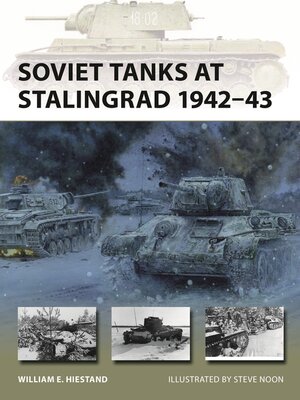
Sign up to save your library
With an OverDrive account, you can save your favorite libraries for at-a-glance information about availability. Find out more about OverDrive accounts.
Find this title in Libby, the library reading app by OverDrive.



Search for a digital library with this title
Title found at these libraries:
| Library Name | Distance |
|---|---|
| Loading... |
Examines and analyses how the Soviet tank forces that fought at Stalingrad were rejuvenated in the months leading up to the battle, and the role they played in this iconic campaign.
The Stalingrad campaign was a major turning point of World War II. The German Sixth Army's 22 divisions and 250,000 troops were encircled and destroyed, while the Soviet 62nd Army's desperate defense of the city and the suffering of the starving German troops receives much justifiable attention.
Here, Soviet armor expert William E. Hiestand draws attention to the less-covered element of the battle: the reborn Soviet tank and mechanized corps that delivered the death blow to Hitler's hopes. He explains how in summer 1942, the Soviet tank forces were failing to reach their potential; despite being equipped with superb T-34 and heavily armored KV-1 tanks, the Red Army's newly formed tank corps were unable to integrate their armored thrusts with supporting infantry and artillery, and their disjoined attacks were repeatedly shattered. By November 19, however, Soviet organization, command and control, training, and tactics had matured, allowing the Fifth Tank Army to launch the decisive penetration through the Romanian Third Army.
Packed with rare archive photos and superb profiles of the tanks involved, this book shows that it was at Stalingrad that the Red Army's armored spearhead evolved into a force that could dominate the Eastern Front.
The Stalingrad campaign was a major turning point of World War II. The German Sixth Army's 22 divisions and 250,000 troops were encircled and destroyed, while the Soviet 62nd Army's desperate defense of the city and the suffering of the starving German troops receives much justifiable attention.
Here, Soviet armor expert William E. Hiestand draws attention to the less-covered element of the battle: the reborn Soviet tank and mechanized corps that delivered the death blow to Hitler's hopes. He explains how in summer 1942, the Soviet tank forces were failing to reach their potential; despite being equipped with superb T-34 and heavily armored KV-1 tanks, the Red Army's newly formed tank corps were unable to integrate their armored thrusts with supporting infantry and artillery, and their disjoined attacks were repeatedly shattered. By November 19, however, Soviet organization, command and control, training, and tactics had matured, allowing the Fifth Tank Army to launch the decisive penetration through the Romanian Third Army.
Packed with rare archive photos and superb profiles of the tanks involved, this book shows that it was at Stalingrad that the Red Army's armored spearhead evolved into a force that could dominate the Eastern Front.







